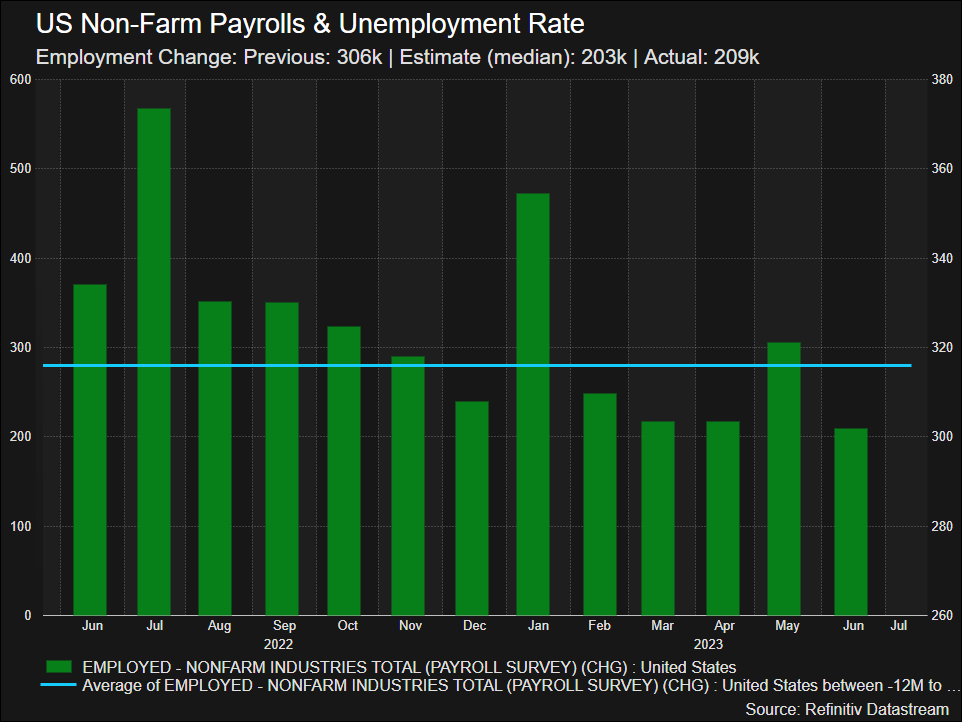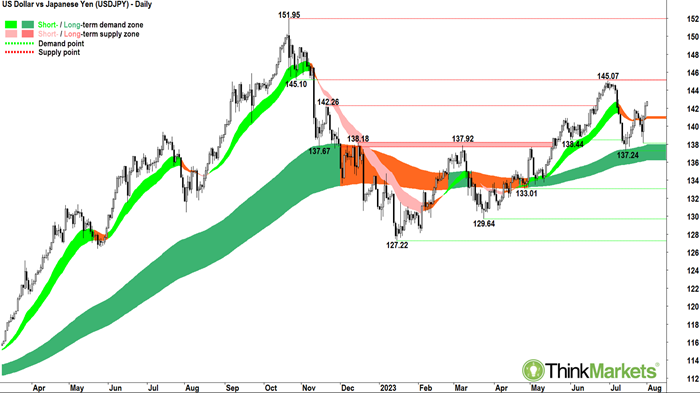
Download Carl’s Bear Market Survival Guide e-Book:
https://www.thinkmarkets.com/au/lp/2023-bear-market-survival-guide-ebook/

Last week the Fed delivered its eleventh interest rate hike in twelve meetings, taking the official cash rate to 5.25%-5.50%. This is the most restrictive policy rate it has set in over 20 years as it continues its fight against the high inflation of the last 12-18 months.
At his scheduled post-meeting press conference, Fed Chairman Jerome Powell indicated rates are likely to remain high for an extended period of time, remarking, “Policy has not been restrictive enough for long enough.” He also noted some damage to the US economy would inevitably result from policy changes to date, noting the US economy could experience “a period of below-trend growth and some softening of labor market conditions.”
Whilst talking tough on inflation and leaving the door open for another interest rate hike when the FOMC meets again in September, Powell also hinted at the possibility of an extended pause, saying “It’s possible that [the Fed] would choose to hold steady and we’re going to be making careful assessments, as I said, meeting by meeting.”
After the Fed’s June meeting pause, Powell’s comments were very specific about “at least” one more hike to come. Tick one off in July, and the big question the market is asking now is: “One or done?“. Market pricing suggests investors are convinced the Fed doesn’t have any bullets left in the chamber, with futures pricing indicating an 81.5% likelihood of “No Change” at the Fed’s September meeting.
Indeed, the pause scenario has grown in popularity for meetings in November through to March 2024 where the first cut in interest rates since 2020 becomes the most likely scenario (“Ease”). Importantly, note also just how much Ease probabilities have grown since before the last Fed meeting (left-hand side) and after (right-hand side). Markets viewed the last meeting as a substantial dovish shift from the US central bank.
But, given Powell has made a point the Fed is going to be data dependant from here, and likely more balanced in its assessment of inflation versus US economic growth, each new piece of data is going to be extremely closely watched by the market. Of particular importance is going to be anything related to the US employment market – which has been singled out by the Fed as the root cause of much of the current inflationary pulse.
This week’s key piece of the inflation puzzle – NFPs
This week, we get the most significant reading of the health of the US jobs market in the form of the Non-Farm Payrolls (NFP) report. Compiled by the Bureau of Labor Statistics (BLS), it surveys both government and private enterprises to determine the number of workers in the US excluding those involved in farming, private enterprise, household business, not-for-profits, and the military.
NFP data is typically released as an increase or decrease in the number of jobs created. Along with each month’s NFP report, investors also get readings on the official US unemployment rate and the change in Average Hourly Earnings. Together, they constitute an important window into the health of the US economy. A strong NFP report indicates a strong economy and increased spending capacity to increase economic growth, and vice versa.
For forex traders, a strong economy is typically associated with higher interest rates, and higher interest rates are typically associated with a stronger domestic currency. The converse is also true. So, it is clear forex traders should pay close attention to NFP data when it is released each first Friday of the month – commencing with this Friday’s release.
How to trade this week’s NFP data
This week, economists are expecting the NFP report to show 203,000 jobs were created in the US economy in the month of July. This is slightly down on June’s 209,000 increase and well below the 12-month rolling average of 316,000 jobs per month. So, it is clear the market is expecting another indication the US jobs market is cooling – and therefore likely so too are inflationary pressures.
A hotter than expected NFP number, for example towards 250,000 or above, would likely see a positive strong reaction in the US dollar, and a strong negative reaction in stocks and bonds as it increases the likelihood the Fed will deliver on its “one more hike to come” scenario. Alternatively, a cooler than expected reading, for example below 180,000, would likely see the US dollar sell off and stocks and bonds rally as it reduces the need for further Fed hikes.
In the first scenario, I would be targeting a currency which is already exhibiting a downtrend against the US dollar, for example the Japanese Yen (JPY). Here, traders could look to enter USDJPY longs with stops set below 137.24. Targets are open ended based upon the price action, but 147.07 and then 151.95 could be an upside pressure points for potential pullbacks.
In the second scenario, I would be targeting a currency which is already exhibiting an uptrend against the US dollar, for example the Swiss Franc (CHF). Here, traders could look to enter USDCHF shorts with stops set above 0.8821. 0.8552 could be an downside pressure point for a minor rally, but below this, targets are open ended based upon the price action.

Learn More, Earn More!
Want your portfolio questions answered? Register for next week’s Live Market Analysis sessions and attend live! You can ask me about any stock, index, commodity, forex pair, or cryptocurrency you’re interested in.
You can catch the replay of the last episode of Live Market Analysis here:
Bank of Japan knocks stocks, hang in or bail out!?










